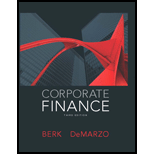
a)
To determine: The unlevered cost of capital of Company A.
Introduction:
The unlevered cost of capital is an assessment utilizing either a theoretical or real obligation-free situation to measure an organisation’s cost to execute a specific capital undertaking. The unlevered cost of capital should illustrate that the project is a more affordable option than a levered cost of capital investment program.
Unlevered cost of capital is a variation of the cost of capital count. Financial specialists may likewise utilize the unlevered cost of capital strategy to decide whether the organisation is a sound venture.
b)
To determine: The unlevered value of project RFX and the present value of interest tax shield.
Introduction:
The unlevered cost of capital is an assessment utilizing either a theoretical or real obligation-free situation to measure an organisation’s cost to execute a specific capital undertaking. The unlevered cost of capital should illustrate that the project is a more affordable option than a levered cost of capital investment program.
Unlevered cost of capital is a variation of the cost of capital count. Financial specialists may likewise utilize the unlevered cost of capital strategy to decide whether the organisation is a sound venture.
c)
To determine: The NPV of loan guarantee.
Introduction:
d)
To determine: The levered value for project RFX, including NPV of loan guarantee and interest tax shield.
Introduction:
The leverage can also refer to the amount of debt used to finance assets. Leverage uses the borrowed funds or various financial instruments to increase the returns on the investment. If a company has high leverage, it means that the instrument has more debt than equity.
Want to see the full answer?
Check out a sample textbook solution
Chapter 18 Solutions
Corporate Finance
 Essentials Of InvestmentsFinanceISBN:9781260013924Author:Bodie, Zvi, Kane, Alex, MARCUS, Alan J.Publisher:Mcgraw-hill Education,
Essentials Of InvestmentsFinanceISBN:9781260013924Author:Bodie, Zvi, Kane, Alex, MARCUS, Alan J.Publisher:Mcgraw-hill Education,

 Foundations Of FinanceFinanceISBN:9780134897264Author:KEOWN, Arthur J., Martin, John D., PETTY, J. WilliamPublisher:Pearson,
Foundations Of FinanceFinanceISBN:9780134897264Author:KEOWN, Arthur J., Martin, John D., PETTY, J. WilliamPublisher:Pearson, Fundamentals of Financial Management (MindTap Cou...FinanceISBN:9781337395250Author:Eugene F. Brigham, Joel F. HoustonPublisher:Cengage Learning
Fundamentals of Financial Management (MindTap Cou...FinanceISBN:9781337395250Author:Eugene F. Brigham, Joel F. HoustonPublisher:Cengage Learning Corporate Finance (The Mcgraw-hill/Irwin Series i...FinanceISBN:9780077861759Author:Stephen A. Ross Franco Modigliani Professor of Financial Economics Professor, Randolph W Westerfield Robert R. Dockson Deans Chair in Bus. Admin., Jeffrey Jaffe, Bradford D Jordan ProfessorPublisher:McGraw-Hill Education
Corporate Finance (The Mcgraw-hill/Irwin Series i...FinanceISBN:9780077861759Author:Stephen A. Ross Franco Modigliani Professor of Financial Economics Professor, Randolph W Westerfield Robert R. Dockson Deans Chair in Bus. Admin., Jeffrey Jaffe, Bradford D Jordan ProfessorPublisher:McGraw-Hill Education





